Freedom, Security, and Humanity:
Urban Security for the 21st Century
International panel discusses the false choices, real decisions, and repercussions of contemporary urban security
by Zach Mortice
Associate Editor
Summary: The Urban Security in the 21st Century panel discussion keynote, Friday, May 16, at the AIA national convention, examined issues of urban security and the built environment from geopolitical, tactical, and humanitarian points of view. It connected the twinned priorities of security and architects’ role in providing infrastructural support for those in need.
[ Watch a video of the discussion ]
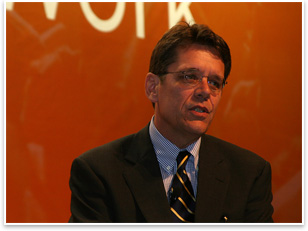 The modern city is more important to the world now than it ever has been and is growing more so every day. Today, more people in the world live in cities than anywhere else. One million people migrate into them every single week. More and more, cities are the civic and economic engines of a nation, still beacons of hope and opportunity for people everywhere. The modern city is more important to the world now than it ever has been and is growing more so every day. Today, more people in the world live in cities than anywhere else. One million people migrate into them every single week. More and more, cities are the civic and economic engines of a nation, still beacons of hope and opportunity for people everywhere.
“They are important symbols,” said Thomas Vonier, FAIA, the moderator for the 2008 AIA Convention’s panel discussion, but also “spectacular targets” for many of the same reasons that they are exerting a stronger than ever pull on society.
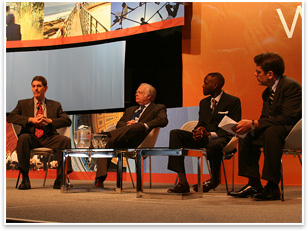 The panel discussion on architecture’s role in contemporary urban security issues looked at the threat of terrorism and infrastructure vulnerability from a diverse array of viewpoints, global and local, to ask the question, as AIA President Marshall Purnell, FAIA, posed it, “Freedom or security—does it have to be a choice?” The panel discussion on architecture’s role in contemporary urban security issues looked at the threat of terrorism and infrastructure vulnerability from a diverse array of viewpoints, global and local, to ask the question, as AIA President Marshall Purnell, FAIA, posed it, “Freedom or security—does it have to be a choice?”
The panelists were (left to right):
- Henry Crumpton, a former CIA agent and Department of State ambassador, who currently is president of the Crumpton Group, a private consulting group that specializes in urban security and maintains offices in Washington, D.C., and Warsaw
- Douglas Woodlock, a federal district judge in Boston, who served as the chair of the New Boston Federal Courthouse Committee that supervised the design and construction of the John Joseph Moakley U.S. Courthouse
- Derreck Kayongo, a native Ugandan, who works for CARE International, a global development non-profit organization dedicated to the elimination of endemic poverty in developing nations
- Thomas Vonier, the panel’s moderator, a founding member of the International Center for Urban Security in Barcelona. He began the discussion with a question: “What can we do better to help our cities prepare for and cope with these kinds of problems and challenges?”
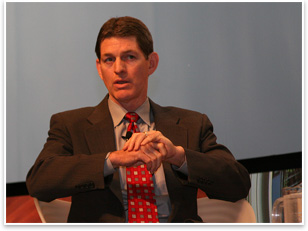 Security is being a good neighbor Security is being a good neighbor
Crumpton analyzed urban security issues from a tactical and geopolitical perspective. He said the primary task with which urban designers should be concerned is grappling with the contemporary reality of “asymmetrical conflict,” where a single terrorist bomber or computer hacker can cause massive damage to a population, regardless of its traditional standing defenses. He pointed out that this type of vulnerability is amplified by the global migration into cities. Crumpton also mentioned the rise in prominence of non-state actors in global conflicts. Whether it’s Al Qaeda or Hamas in the Middle East or FARC in Columbia, more and more autonomous groups apart from standard military hierarchy are able to exert their influence beyond their local environs. Crumpton said this shift away from marching armies has left the U.S. unprepared. “This is less about army on army and more about people—We the People,” he said, acknowledging the other side of the 2008 Boston convention’s theme of architects’ populist responsibility.
Dynamic intelligence, not static fortification, is what is most important in urban security, Crumpton said. “Security in many cases is less about physical barriers and more about having intelligence, and the most effective intelligence is not through coercion, not through surveillance, not through some pervasive Orwellian security system,” he said. “It is far more about trusted networks. So how do you as architects design those kinds of communities, those kinds of buildings that help develop networks of trust?”
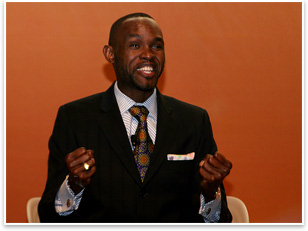 Poverty and security Poverty and security
Vonier asked Kayongo for his perspective on the intersections between developing economies and security. Kayongo replied that to understand this, one has to come to a massive redefinition of what “security” means to much of the impoverished developing world. People in Kayongo’s native Uganda don’t often think of security measures as annoyances cluttering up their favorite civic landmarks, or as insurance against an unlikely tragedy. For them, security is as elemental and omnipresent as food, shelter, and health. This type of abject poverty, Kayongo says, can be a key driver of insecurity everywhere. “It’s easy to come to my community and recruit people for anything if you can promise them a loaf of bread,” he said.
 Later, Crumpton pointed out that this kind of inequality-bred antagonism is fueled by the shrinking, globalizing world. As people in developing nations understand more about Westerner’s luxurious lifestyles, resentment grows. “You as architects,” Kayongo said, “can create housing we can afford. You can develop ideas about how to construct new communities that don’t create confrontation. You can be very imaginative in how you include communities in [their own] innovations.” Later, Crumpton pointed out that this kind of inequality-bred antagonism is fueled by the shrinking, globalizing world. As people in developing nations understand more about Westerner’s luxurious lifestyles, resentment grows. “You as architects,” Kayongo said, “can create housing we can afford. You can develop ideas about how to construct new communities that don’t create confrontation. You can be very imaginative in how you include communities in [their own] innovations.”
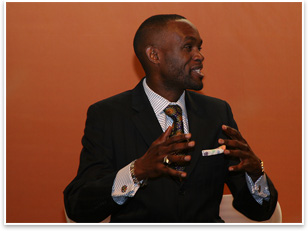 Though spoken by men born decades and continents apart, Kayongo’s comments on the dire human need for adequate infrastructure and housing echoed the words of the previous day’s speaker Millard Fuller, the founder of Habitat for Humanity International. Both implored architects to design for those without a voice in hope of unlocking self-actualization. Fuller cast his speech as a genial inspirational sermon; Kayongo’s words, however, were weighted with his own experiences growing up in a impoverished sub-Saharan Africa and by the presence of Crumpton and Vonier, two security experts with intimate knowledge of the limits of protection that the built environment can offer when the least among us try to do the most harm. Though spoken by men born decades and continents apart, Kayongo’s comments on the dire human need for adequate infrastructure and housing echoed the words of the previous day’s speaker Millard Fuller, the founder of Habitat for Humanity International. Both implored architects to design for those without a voice in hope of unlocking self-actualization. Fuller cast his speech as a genial inspirational sermon; Kayongo’s words, however, were weighted with his own experiences growing up in a impoverished sub-Saharan Africa and by the presence of Crumpton and Vonier, two security experts with intimate knowledge of the limits of protection that the built environment can offer when the least among us try to do the most harm.
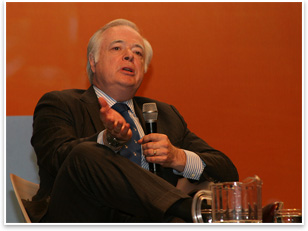 Beyond the bunker Beyond the bunker
Woodlock spoke of his own experiences in balancing the seemingly opposed values of freedom and security when he was involved in the building of the John Joseph Moakley U.S. Courthouse, which is just “shooting distance,” he quipped, from the Boston convention center. Initially, his committee was not particularly concerned with external security. The design, by Harry Cobb, FAIA, of Pei Cobb Freed, was a pedestrian-friendly city in miniature that sought to engage the adjacent waterfront. Then, in 1994, the Alfred P. Murrah Federal Building in Oklahoma City was bombed, and external threats moved to the forefront of the design agenda.
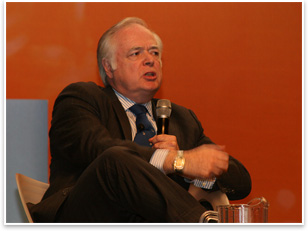 Woodlock said that people started to back away from the streetscape-engaging features of the building. “We had to take a stand, and the stand we had to take is to be engaged with the city more than anything else,” he said. Then, despite what any other federal courthouse client might say, Woodlock implored architects not to make such statements of civic pride “bunkers.” Woodlock said that people started to back away from the streetscape-engaging features of the building. “We had to take a stand, and the stand we had to take is to be engaged with the city more than anything else,” he said. Then, despite what any other federal courthouse client might say, Woodlock implored architects not to make such statements of civic pride “bunkers.”
Beyond design intent, Vonier asked the panel how the built environment can reinforce a sense of security in the public at large. Are common signifiers like barriers and metal detectors enough, or are these merely elements of “security theater?”
Woodlock called for a “semiotics of security,” and said he’s mostly skeptical of the way most government centers have handled this responsibility. He said it is appropriate for ideal security parameters to be subordinate to design sensibilities in some situations. “I’m not sure the goal of our policy ought to be to make the Secret Service’s life easier,” he said.
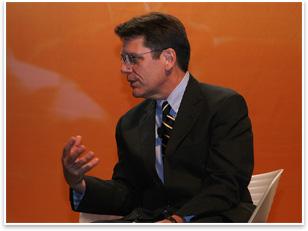 Vonier referred this idea back to urbanist and author Jane Jacobs’ thoughts on urban security and proprietary interest. Jacobs saw urban security as an almost purely social function, in that well-designed neighborhoods with a mix of uses that keep people in public at all hours of the day would be the most secure because the “eyes on the street,” as she said, would serve as a de facto security presence, personally invested in the civic life of their neighborhood. No one knows if Jacobs might have ever expected to hear her thoughts echoed by a former CIA agent and private consultant such as Crumpton, but his ideas on urban security and the necessity of fluid and porous community relationships also illustrates urban security as a social entity. Vonier referred this idea back to urbanist and author Jane Jacobs’ thoughts on urban security and proprietary interest. Jacobs saw urban security as an almost purely social function, in that well-designed neighborhoods with a mix of uses that keep people in public at all hours of the day would be the most secure because the “eyes on the street,” as she said, would serve as a de facto security presence, personally invested in the civic life of their neighborhood. No one knows if Jacobs might have ever expected to hear her thoughts echoed by a former CIA agent and private consultant such as Crumpton, but his ideas on urban security and the necessity of fluid and porous community relationships also illustrates urban security as a social entity.
The most global and universal perspective of the discussion came from Kayongo, who talked about sustainability as a function of security. The more unsustainable communities that are built, the more opportunities are opened for catastrophic weather events and infrastructure failure.
In a way, each of the panelists acknowledged that any separation between humanitarian concerns and security concerns is artificial and antithetical. It is the architects’ job, as Crumpton said, to join these two issues “though urban centers that encourage trust and cooperation, and contribute to this community of global nations.”
|


 The modern city is more important to the world now than it ever has been and is growing more so every day. Today, more people in the world live in cities than anywhere else. One million people migrate into them every single week. More and more, cities are the civic and economic engines of a nation, still beacons of hope and opportunity for people everywhere.
The modern city is more important to the world now than it ever has been and is growing more so every day. Today, more people in the world live in cities than anywhere else. One million people migrate into them every single week. More and more, cities are the civic and economic engines of a nation, still beacons of hope and opportunity for people everywhere. The panel discussion on architecture’s role in contemporary urban security issues looked at the threat of terrorism and infrastructure vulnerability from a diverse array of viewpoints, global and local, to ask the question, as AIA President Marshall Purnell, FAIA, posed it, “Freedom or security—does it have to be a choice?”
The panel discussion on architecture’s role in contemporary urban security issues looked at the threat of terrorism and infrastructure vulnerability from a diverse array of viewpoints, global and local, to ask the question, as AIA President Marshall Purnell, FAIA, posed it, “Freedom or security—does it have to be a choice?”  Security is being a good neighbor
Security is being a good neighbor Poverty and security
Poverty and security Later, Crumpton pointed out that this kind of inequality-bred antagonism is fueled by the shrinking, globalizing world. As people in developing nations understand more about Westerner’s luxurious lifestyles, resentment grows. “You as architects,” Kayongo said, “can create housing we can afford. You can develop ideas about how to construct new communities that don’t create confrontation. You can be very imaginative in how you include communities in [their own] innovations.”
Later, Crumpton pointed out that this kind of inequality-bred antagonism is fueled by the shrinking, globalizing world. As people in developing nations understand more about Westerner’s luxurious lifestyles, resentment grows. “You as architects,” Kayongo said, “can create housing we can afford. You can develop ideas about how to construct new communities that don’t create confrontation. You can be very imaginative in how you include communities in [their own] innovations.” Though spoken by men born decades and continents apart, Kayongo’s comments on the dire human need for adequate infrastructure and housing echoed the words of the previous day’s speaker Millard Fuller, the founder of
Though spoken by men born decades and continents apart, Kayongo’s comments on the dire human need for adequate infrastructure and housing echoed the words of the previous day’s speaker Millard Fuller, the founder of  Beyond the bunker
Beyond the bunker Woodlock said that people started to back away from the streetscape-engaging features of the building. “We had to take a stand, and the stand we had to take is to be engaged with the city more than anything else,” he said. Then, despite what any other federal courthouse client might say, Woodlock implored architects not to make such statements of civic pride “bunkers.”
Woodlock said that people started to back away from the streetscape-engaging features of the building. “We had to take a stand, and the stand we had to take is to be engaged with the city more than anything else,” he said. Then, despite what any other federal courthouse client might say, Woodlock implored architects not to make such statements of civic pride “bunkers.”  Vonier referred this idea back to urbanist and author Jane Jacobs’ thoughts on urban security and proprietary interest. Jacobs saw urban security as an almost purely social function, in that well-designed neighborhoods with a mix of uses that keep people in public at all hours of the day would be the most secure because the “eyes on the street,” as she said, would serve as a de facto security presence, personally invested in the civic life of their neighborhood. No one knows if Jacobs might have ever expected to hear her thoughts echoed by a former CIA agent and private consultant such as Crumpton, but his ideas on urban security and the necessity of fluid and porous community relationships also illustrates urban security as a social entity.
Vonier referred this idea back to urbanist and author Jane Jacobs’ thoughts on urban security and proprietary interest. Jacobs saw urban security as an almost purely social function, in that well-designed neighborhoods with a mix of uses that keep people in public at all hours of the day would be the most secure because the “eyes on the street,” as she said, would serve as a de facto security presence, personally invested in the civic life of their neighborhood. No one knows if Jacobs might have ever expected to hear her thoughts echoed by a former CIA agent and private consultant such as Crumpton, but his ideas on urban security and the necessity of fluid and porous community relationships also illustrates urban security as a social entity.